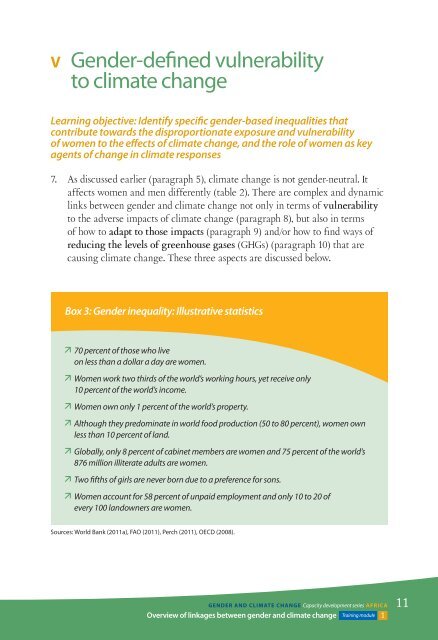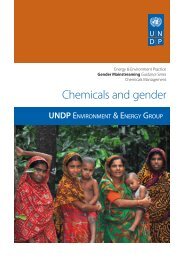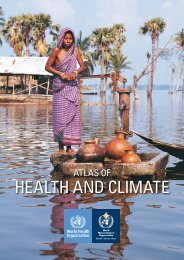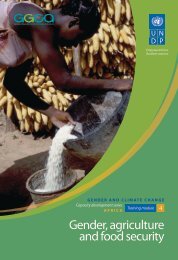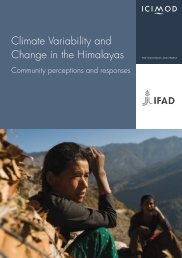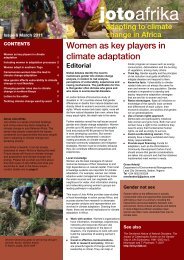Overview of linkages between gender and climate change
Overview of linkages between gender and climate change
Overview of linkages between gender and climate change
Create successful ePaper yourself
Turn your PDF publications into a flip-book with our unique Google optimized e-Paper software.
V Gender-defined vulnerability<br />
to <strong>climate</strong> <strong>change</strong><br />
Learning objective: Identify specific <strong>gender</strong>-based inequalities that<br />
contribute towards the disproportionate exposure <strong>and</strong> vulnerability<br />
<strong>of</strong> women to the effects <strong>of</strong> <strong>climate</strong> <strong>change</strong>, <strong>and</strong> the role <strong>of</strong> women as key<br />
agents <strong>of</strong> <strong>change</strong> in <strong>climate</strong> responses<br />
7. As discussed earlier (paragraph 5), <strong>climate</strong> <strong>change</strong> is not <strong>gender</strong>-neutral. It<br />
affects women <strong>and</strong> men differently (table 2). There are complex <strong>and</strong> dynamic<br />
links <strong>between</strong> <strong>gender</strong> <strong>and</strong> <strong>climate</strong> <strong>change</strong> not only in terms <strong>of</strong> vulnerability<br />
to the adverse impacts <strong>of</strong> <strong>climate</strong> <strong>change</strong> (paragraph 8), but also in terms<br />
<strong>of</strong> how to adapt to those impacts (paragraph 9) <strong>and</strong>/or how to find ways <strong>of</strong><br />
reducing the levels <strong>of</strong> greenhouse gases (GHGs) (paragraph 10) that are<br />
causing <strong>climate</strong> <strong>change</strong>. These three aspects are discussed below.<br />
Box 3: Gender inequality: Illustrative statistics<br />
ÊÊ70 percent <strong>of</strong> those who live<br />
on less than a dollar a day are women.<br />
ÊÊWomen work two thirds <strong>of</strong> the world’s working hours, yet receive only<br />
10 percent <strong>of</strong> the world’s income.<br />
ÊÊWomen own only 1 percent <strong>of</strong> the world’s property.<br />
ÊÊAlthough they predominate in world food production (50 to 80 percent), women own<br />
less than 10 percent <strong>of</strong> l<strong>and</strong>.<br />
ÊÊGlobally, only 8 percent <strong>of</strong> cabinet members are women <strong>and</strong> 75 percent <strong>of</strong> the world’s<br />
876 million illiterate adults are women.<br />
ÊÊTwo fifths <strong>of</strong> girls are never born due to a preference for sons.<br />
ÊÊWomen account for 58 percent <strong>of</strong> unpaid employment <strong>and</strong> only 10 to 20 <strong>of</strong><br />
every 100 l<strong>and</strong>owners are women.<br />
Sources: World Bank (2011a), FAO (2011), Perch (2011), OECD (2008).<br />
Gender <strong>and</strong> Climate Change Capacity development series Afric a<br />
<strong>Overview</strong> <strong>of</strong> <strong>linkages</strong> <strong>between</strong> <strong>gender</strong> <strong>and</strong> <strong>climate</strong> <strong>change</strong> Training module 1<br />
11


